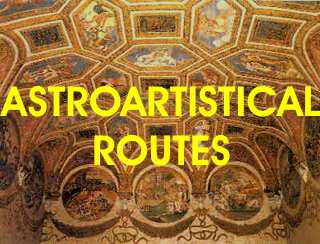S. Lorenzo
Old Chapel - Firenze |
In Florence the first painted horoscope was performed: it can be found in the little
dome above the altar in the St. Lawrence's Old Sacristy. This map of the sky attributed to
Giuliano d'Arrigo, called Pesello, shows all the astronomic elements with extreme
precision: the ecliptic with the zodiacal constellations and the Sun set between
Gemini and Cancer, the meridians, the North Pole and the planets in transit put in
particolar positions.
In the dome of St. Lawrence the star position is the one observed on the sky in Florence
in a determined moment and a particular day, perhaps July 4, 1442.
The artist, skilled and extraordinary animalist close to the miniaturistic tradition , was
assisted by an astronomer: probably Paolo dal Pozzo Toscanelli, friend of Brunelleschi and
Leon Battista Alberti.
The work is performed with an unusual and precious technique: a dried painting on a bottom
of azurrite, with the gilded astronomic elements "at leaf".
The comitence must be counted to Cosimo the Old that began a tradition of interest toward
astrology from the De Medici family. This interest was in tuning with the tradition and
the cultural events of the town: just to remember that in the library of St. Mark the
numerous astrological and hermetic texts came all systematized in great evidence. It was
however during the 1439 Council that it was done more alive the interest for the
philosophy neoplatonica and the hermetic tradition.
top
The Zodiac of
Dendera gives a brief glimpse into aspects of Nile Valley astronomy, astrology,
agriculture and calendar making. The inner circle of figures, which move counter clockwise
like the stars, shows the astrological signs of the zodiac circling around the North Pole,
which is symbolized by the deity Anpu. The outer circle of figures represents the 36
decans (ten day weeks) of the Egyptian year. Thus one had a circle (36 * 10 = 360
degrees). The twelve figures outside the circle represent the 12 months of the year and
their arms, the 24 hours of the day. It was in this manner that the 12 signs of the
zodiac, which regulated agriculture, were created. Each sign was associated with a decan
and was called one of "the watchers of the hours." The word "hour"
derives from the deity Heru or Horus. Thus the signs of the zodiac were also "the
watchers of Heru/Horus" and hence the origin of the word "Horoscope."
http://www.geocities.com/CollegePark/Classroom/9912/egypthistory.html
top
The
astronomical clock of Prague |
In 1410 the master
watchmaker Mikulas of Kadan built a clock that was put in the inferior portion of the Town
hall's Tower of Staré Mesto in the Old City. In 1490 the master Hanus was dealt
with his setup and realized it as today we can admire. In Praga a legend was told: Hanus
would have been blinded in order to not building an identical work; the master, however,
would be avenged damaging it, after having been introduced him in the clock. This the
legend. Reality is different. Hanus was never blinded, on the contrary he kept on working
as watchmaker. It seems true, instead, that the clock didn't work well until when a
certain J.Tabosky, around 1570, didn't mend it. The clock is composed by two quadrants,
with 8 figures, four at the side of the superior quadrant and four at the side in the
inferior one. Above the superior quadrant, two windows, known as "Apostles'
Procession".The four figures of the superior quadrant symbolize "Vanity",
"Avarice", "Death" and "Luxury".
But what happens
when it beats the time? Death plays a bell and overturns hourglass that has in the left
hand, do the Apostles start to pass behind the two windows bending themselves toward
the crowd: from the left window for first Paul passes with a sword and a book, then Thomas
with a lance and, following, Juda with a book, Simone with a saw and Bartholomew with a
book; from the window of right Peter with a key, Mathew with an ax, John with a
snake,
Andrew with a cross, Phillip with a cross and James with a wood hammer.
top
The
astronomical clock of Cremona, Italy |
|
It is
situated in TownHall Place, Dome Cathedral: The right side of the Torrazzo
entertained a great sundial realized at the beginning of the last century by
the native General Francis Pistoia of Dovarese Island . It replaced a previous
one by now had been wearing out for the time, of which traces exist on still
the masonry. The General Francis Pistoia's one had a big gnome 287,7cm long,
still installed on the wall. The floor of the Torrazzo's room where
the car of the Astronomic clock is found, is realized a horizontal
sundial that takes light from a practiced hole in the ceiling. This sundial
didn't have a public function as that external, but it served to an
appointee to syncronize the visible clock from the underlying square with
the daily run of the Sun: this way the mechanical clock could correctly
point out the time true place.
http://www.rccr.cremona.it/gac/
|
top
|

